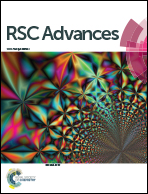Hydrophilic molecularly imprinted microspheres functionalized with amino and carboxyl groups for highly selective recognition of human hemoglobin in aqueous solution†
Abstract
The hydrophilic molecularly imprinted microspheres (HMIMs) functionalized with amino and carboxyl groups have been synthesized successfully using human hemoglobin as a template. The obtained HMIMs have been characterized using scanning electron microscopy (SEM), adsorption isotherms, dynamic binding as well as quartz crystal microbalance (QCM). The rebinding results indicate that the HMIMs exhibit highly selective recognition properties towards target human hemoglobin in Tris–HCl aqueous solution with an imprinting factor of 1.90 and a high binding capacity of 98 mg g−1. The QCM characterization results also demonstrate that the HMIMs coated electrode shows a more sensitive response to hemoglobin than that of a non-imprinted microspheres coated electrode.


 Please wait while we load your content...
Please wait while we load your content...